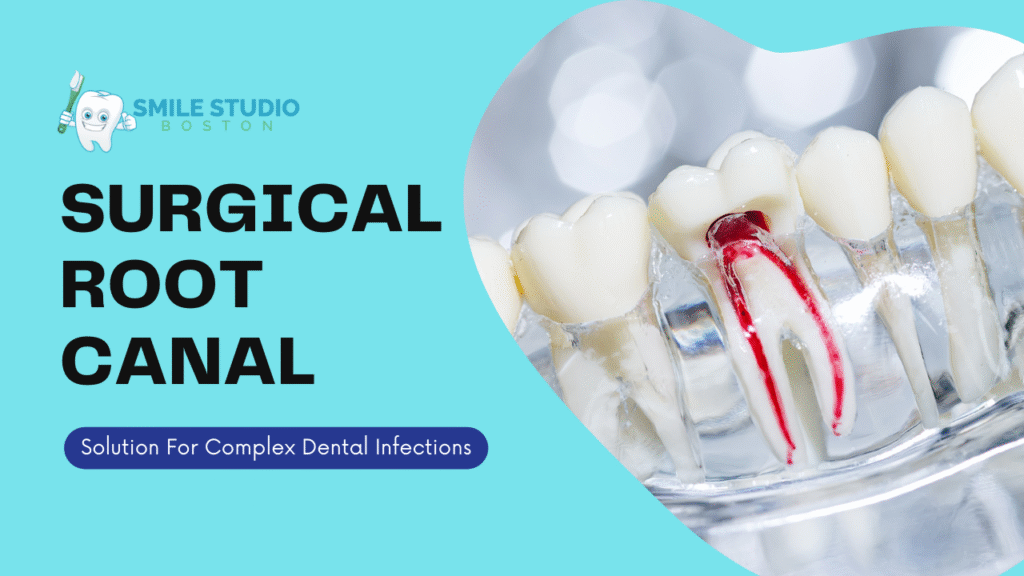Preserving natural teeth is a fundamental goal in dentistry. When decay or infection reaches the tooth’s pulp, root canal treatments become essential. While non-surgical root canal procedures are common, certain situations necessitate a surgical approach to effectively address complex dental infections.
I. Understanding Root Canal Procedures
A non-surgical root canal, also known as non-surgical endodontic treatment, involves removing infected or damaged pulp from within the tooth. The procedure cleans and seals the canals, preserving the tooth’s structure and function. This treatment is typically sufficient for most cases of pulp infection or inflammation.
II. When Is a Surgical Root Canal Necessary?
In some instances, non-surgical root canals may not fully resolve the issue. Surgical intervention becomes necessary when:
- Persistent infection or inflammation remains after a non-surgical procedure.
- The tooth has complex root anatomy that hinders thorough cleaning.
- There is a need to repair a damaged root surface or surrounding bone.
These scenarios highlight the importance of surgical root canal treatments in effectively managing dental infections.
III. The Surgical Root Canal Procedure
A surgical root canal, often referred to as an apicoectomy, involves several critical steps:
- Anesthesia: Local anesthesia is administered to ensure patient comfort.
- Incision: A small incision is made in the gum tissue near the affected tooth to access the underlying bone and root.
- Removal of Infected Tissue: Inflamed or infected tissue, along with the tip of the root, is carefully removed.
- Sealing: A small filling is placed to seal the end of the root canal.
- Suturing: The gum tissue is sutured back into place to facilitate healing.
This procedure is typically performed by an endodontist, a specialist in treating complex dental issues.
IV. Surgical vs Non-Surgical Root Canal: Key Differences
When comparing surgical and non-surgical root canal treatments, several factors come into play:
- Procedure: Non-surgical involves accessing the tooth’s interior through the crown, while surgical requires an incision in the gum tissue.
- Recovery Time: Surgical procedures may involve a slightly longer recovery period due to the incision and suturing.
- Success Rates: Studies indicate that surgical root canals have a success rate of approximately 77.6%, whereas non-surgical retreatments have a success rate of about 65.5%.
The choice between surgical and non-surgical approaches depends on the specific circumstances of each case.
V. Benefits of Surgical Root Canal Treatment
Opting for a surgical root canal offers several advantages:
- Preservation of Natural Teeth: It allows for retaining the natural tooth, maintaining functionality and aesthetics.
- Effective Infection Management: Addresses issues that non-surgical treatments cannot resolve, ensuring thorough infection control.
- Long-Term Solution – Reduces the risk of reinfection and future dental complications.
These benefits underscore the value of surgical intervention in complex dental cases.
Recovery and Aftercare
Post-operative care is crucial for successful healing:
- Follow Instructions: Adhere to the dentist’s guidelines regarding diet, oral hygiene, and medication.
- Monitor Healing: Attend follow-up appointments to ensure proper recovery.
Proper aftercare promotes optimal healing and reduces the risk of complications.
Is a Root Canal a Surgery?
A common question “is a root canal a surgery.” A standard, non-surgical root canal is not considered surgery; it is a routine procedure performed within the tooth’s structure. However, when a root canal requires surgical intervention, such as an apicoectomy, it is classified as a surgical procedure.
VI. Start Your Journey to a Radiant Smile with SmileStudio!
Consulting with dental professionals is essential when facing complex dental infections. Timely surgical root canal treatments can preserve natural teeth and restore oral health.
At SmileStudio, we believe everyone deserves a confident smile. From routine checkups to advanced cosmetic and emergency dental care, our expert team is here to help.
Why Choose SmileStudio?
✔ Top-Rated Dentists: Specialists in crowns, implants, veneers, and more.
✔ Flexible Payment Plans: Affordable options to fit your budget.
✔ Emergency Dental Care: Immediate attention when you need it most.
✔ Walk-In Appointments: Convenient care without the wait.
✔ MassHealth Accepted: Quality care, regardless of your insurance plan.
Book Your Appointment Today!
📞 Call: +1 (617) 265-5606
📧 Email: smilestudioboston@gmail.com
🌐 Visit: smilestudioboston.com
📍 Location: 1428 Dorchester Ave, Dorchester, MA 02122
SmileStudio: Where Beautiful Smiles Begin!

FAQs
1. What happens in the surgical root canal procedure?
A root canal involves removing infected pulp, cleaning the canal, and sealing it with a filling or crown to prevent reinfection.
2. Which tooth is most difficult for a root canal?
Molars, especially upper second molars, are the hardest due to their multiple canals and complex root structure.
3. Is a surgical root canal painful?
With local anesthesia, the procedure is usually painless, though mild discomfort may occur afterward.
4. Which tooth is easiest for a root canal?
Front teeth (incisors and canines) are the easiest since they usually have a single, straight canal.
5. How long is the procedure of surgical root canal?
The procedure typically takes 60–90 minutes, but complex cases may require multiple visits.


